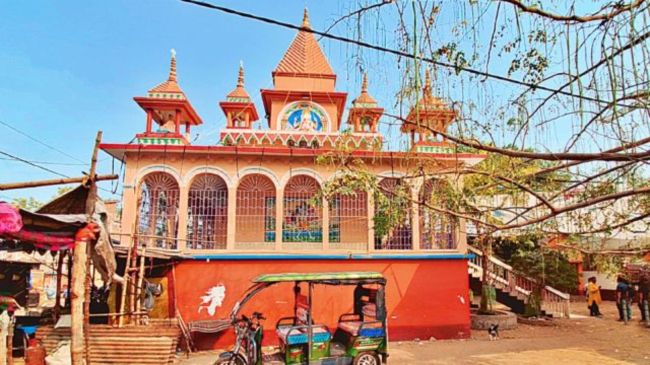Opinion The Bengal caste question is complex. It lies beyond visibility and participation
Caste as a political category in Bengal is independent of Bhadralok hegemony and has a long way to go before it could decide the political fate of the state
 The temple in Gidhagram village in Purba Bardhaman district of West Bengal. (Photo: Partha Paul)
The temple in Gidhagram village in Purba Bardhaman district of West Bengal. (Photo: Partha Paul) The reports of Dalits being denied entry into a West Bengal temple – later, they were cordoned off by the police and performed puja, ending a practice prevalent for more than two hundred years – again sparked the age-old debate on the relevance of caste in the state.
The scholars are generally divided into two camps: One denies Bengal’s exceptionalism and the other still finds echoes of Bhadralok hegemony that was a historical product of 19th-century Bengal renaissance. The field-level realities, however, lie somewhere in between.
To be precise, in rural Bengal, it is hard to find visible cleavage between Bhadraloks and the subalterns. Even in the heyday of Left rule, they always remained connected and the landed quasi-Zamindar class dominated through their control over the forces of production that ranged from their dominant share in the local cold-storage to access to irrigation water.
This economic equation superseded caste boundaries. There are numerous examples of cross-caste partnerships between Brahmin and Dalits to extract and maximise their economic gains. This has continued even after the 2011 electoral defeat of the left and the rise of TMC. The Bhadralok-subaltern division, at best, should be seen as an academic construct that doesn’t really have much field-level reality in rural Bengal.
It is argued that Dalits are underrepresented in the cabinet and that upper-caste Bhadralok dominates the West Bengal Assembly. While this is true in terms of numbers, it is also important to understand that politics is not only about representation in the cabinet or assembly; politics is much more about the grassroots and who controls and decides on the common resources. Although there is a dearth of field-level studies, the recent revealing of extra-legal economic transactions under the leadership of characters like Sk Shahjahan is symptomatic of the formation and sustenance of informal cronyism of capital at the grassroots. The question, therefore, is: Who capitalises on it? Does it follow any caste pattern?
Subalterns are everywhere, from government offices where people go to get services to the local clubs that allegedly engage in illegal exchanges. The hegemonic political control of Bengali Bhadralok is a story of the past, the so-called subalterns are in control of the huge sums of informal economic transactions. Even in mainstream politics, the Bhadralok is not very relevant. With the advent of social media and the shrinking of traditional print media, their major instrument to expand hegemony is also minuscule.
We need to look at the caste question in the context of this new socio-economic reality. Caste as a political instrument in Bengal is often exemplified by assertions of the Matua which is now divided among the BJP and TMC on the issues of citizenship, TMC’s formation of different caste-based development boards like Bauri, Namasudra, Rajbangshi, Kurmi, Bagdi and Kami, formation of Dalit Sahitya Academy, declaring holiday on account of Panchanan Barma’s birthday, or naming the university at Cooch Behar as Coach Behar Panchanan Barma University. However, the unaddressed question is: What do these caste groups want? How far and in what ways is caste mobilisation affecting the political dynamics of the state?
These caste groups do have a variety of aspirations and they are not consolidated. Their demands range from separate statehood to tribal status. The lack of consolidated demands makes the caste groups relatively easy prey for the major political parties including the TMC and BJP. Their assertions are then appropriated in a top-down manner by the formation of development boards in the name of castes. This forestalls any pan-state consolidated caste-based demands and caste politics in Bengal remains microscopic and relatively insignificant.
The larger trait of West Bengal politics in recent decades is threefold: First, the appropriation of identity both by the BJP and TMC, which is theorised as cultural misrecognition, a mechanism that major political parties employ to get political patronage bypassing public service delivery; second, is the appropriation of block voting based on clusters of populations in the name of identity, third, the increasing dominance of informal cronyism that revolves around appropriation of natural resources like land, sand, forest, water, and property through a political-economic model known as franchise politics.
It is important to reiterate that caste as a social category has been timeless in West Bengal and it is also constantly transforming, once through land reforms, then through participation in formal employment and now through participation in non-formal quasi-legal capital ventures under the ruling party. Caste as a category is still important but caste as a political category in Bengal is independent of Bhadralok hegemony and has a long way to go before it could decide the political fate of the state.
The writer teaches anthropology in Dr APJ Abdul Kalam Government College, Kolkata, and has written extensively on grassroots Bengal politics






